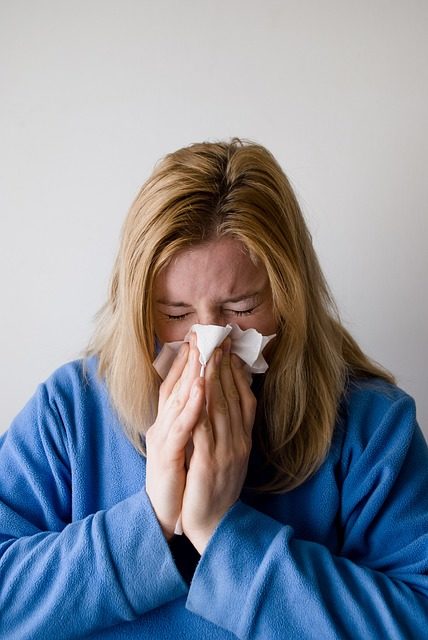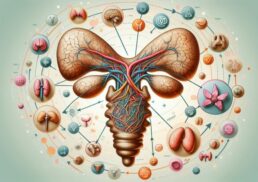Have you ever wondered why some people can savor a peanut butter sandwich without any issue, while others experience severe reactions from merely being in the same room with peanuts? Welcome to the complex world of allergies. Allergies are a prevalent and often misunderstood condition. In this comprehensive guide, we will unravel the allergen mystery by exploring the intricacies of allergies, from common food allergens to airborne substances that can trigger symptoms. By understanding the underlying causes, symptoms, diagnosis, and treatment options, you’ll be better equipped to manage and prevent allergies in your daily life.
Table of Contents
Key Takeaways
Understanding food allergens requires knowledge of the top-9 allergens and reading food labels.
Allergy management and treatment involve allergen avoidance, medications, immunotherapy to reduce symptoms & improve quality of life.
Taking preventative measures can help reduce exposure to environmental allergens & minimize risk of allergic reactions.
Understanding Food Allergens

Food allergies are a common and sometimes perplexing phenomenon. When the immune system reacts to a particular food, it produces an antibody, leading to an allergic reaction. But why does this happen? The immune system is designed to protect the body from harmful substances, yet sometimes it erroneously perceives a generally innocuous substance as a hazardous intruder, leading to an allergic reaction. A wide variety of substances can act as allergens, underlining the importance of examining food labels for possible allergens.
The top-9 allergens, especially in packaged foods, can be particularly troublesome for those with food allergies. Reading the food label is essential for consumers to avoid these allergens. The FDA has conducted surveys to estimate the prevalence of undeclared allergens in food products, revealing that people can develop allergies to a wide range of substances.
Most Common Food Allergies
While there are many possible food allergens, some are far more common than others. The most prevalent food allergens include:
Peanut: allergy symptoms can range from mild itching to severe anaphylaxis, a life-threatening reaction.
Egg: allergies affect between 0.5% to 2.5% of young children and can lead to symptoms such as hives, digestive issues, and respiratory problems.
Sesame: allergies can cause symptoms like hives, itching, and swelling in the lips, tongue, or throat, and in severe cases, anaphylaxis.
Awareness of these prevalent allergens and implementing precautions to avoid exposure and control symptoms is important.
Equipped with the knowledge of which foods are most likely to cause allergies, individuals can make informed choices when selecting ingredients for their meals. For those in search of intelligent and straightforward alternatives for regularly used ingredients, there is a wealth of resources available.
Immune System’s Role
The immune system significantly contributes to the development of allergies. Exposure to an allergen prompts the immune system to produce antibodies that remain on high alert for that specific allergen. Upon subsequent exposure, these antibodies can release immune system chemicals, such as histamine, that result in allergy symptoms. Histamine causes symptoms like:
runny nose
sneezing
itching
inflammation
Histamine also stimulates the secretion of pro-inflammatory cytokines, which contribute to the advancement of allergic-inflammatory responses.
The immune system’s erroneous perception of harmless substances as detrimental leads to allergy symptoms. By understanding the immune system’s role in allergies, individuals can better recognize the cause of their symptoms and take appropriate steps to manage and prevent allergic reactions.
Airborne Allergens and Allergic Rhinitis

Apart from food allergens, substances in the air can also incite allergic reactions. Known as inhalant allergies, these airborne substances, when inhaled, can cause symptoms such as sneezing, congestion, and an itchy nose. Perennial allergens, which can elicit allergies for an extended period, are another concern for those susceptible to allergic reactions.
One common manifestation of airborne allergies is allergic rhinitis, also known as hay fever. Allergic rhinitis is an allergic reaction that results in symptoms such as sneezing, congestion, and an itchy nose, triggered by allergens such as pollen, mold, animal dander, or dust. Comprehending the differences between seasonal and perennial allergies enables individuals to implement suitable measures to control their symptoms and reduce exposure to allergens.
Symptoms of Allergic Rhinitis
Allergic rhinitis can cause a variety of symptoms that may be disruptive to daily life. Indications of allergic rhinitis include:
Sneezing
A runny or congested nose
Itchy eyes, nose, or throat
Postnasal drip
The intensity of symptoms is contingent upon the individual’s allergies and their immune response to allergens, meaning symptoms can differ in intensity between individuals.
Neglecting to manage allergic rhinitis may lead to a range of complications, including:
Sleep deprivation
Daytime fatigue
Learning difficulties
Diminished cognitive ability
Upper and lower respiratory diseases
Nasal polyps
Sinusitis
Increased probability of developing asthma and other allergies
Hence, recognizing and treating the symptoms of allergic rhinitis is important for sustaining overall health and well-being.
Seasonal vs. Perennial Allergies
The distinction between seasonal and perennial allergies is important when managing allergic symptoms.
Seasonal allergies take place during specific periods of the year and are caused by airborne allergens such as:
Pollen
Mold spores
Animal dander
Dust mites
Certain foods
In particular, ragweed is the most common allergen for fall allergies.
On the other hand, perennial allergies, also known as year-round allergies, are a type of allergic reaction that transpires continually throughout the year. They are caused by allergens that are present all year long, such as dust mites, pet dander, mold spores, and certain foods. Treatment options for both seasonal and perennial allergies may include avoidance of allergens, utilization of allergy medications, and immunotherapy.
Learn more, visit Differentiate between seasonal allergy and perennial allergy.
Allergic Reactions: From Mild to Severe
Allergic reactions can vary in intensity from mild to extreme, including severe allergies. When an allergic reaction occurs, the indications may include:
slight itching
sneezing
hives
swelling
difficulty breathing
wheezing
coughing
chest tightness
nausea
vomiting
diarrhea
In severe cases, allergic reactions can lead to life-threatening anaphylaxis. Some of the most frequent stinging insects known to induce allergic reactions include bees, wasps, hornets, yellow jackets, and fire ants. Alongside these, the severity of an allergic reaction can change over time. Allergies can be unpredictable and can range from mild to severe. Prolonged exposure to allergens may result in the emergence of new allergies or an increase in the intensity of existing allergies.
Understanding the spectrum of possible allergic reactions allows individuals to better equip themselves for and control their allergies. This knowledge can help in the development of appropriate preventative measures, treatment plans, and emergency response strategies for those experiencing allergic reactions.
Anaphylaxis: Signs and Treatment
Anaphylaxis is a potentially life-threatening emergency situation that requires immediate attention. Indications of anaphylaxis include:
Difficulty in breathing
Rapid or weakened pulse
Skin rash or hives
Nausea and vomiting
Swelling of the face, lips, or throat
The initial aid treatment for anaphylaxis is to administer adrenaline (epinephrine) by injecting it into the outer mid-thigh muscle. It is imperative to seek emergency medical treatment even if symptoms begin to improve.
In the event of an anaphylaxis emergency, an epinephrine auto-injector should be utilized by injecting the medicine into the fleshy outer portion of the thigh, not into a vein or the buttocks. The injector should be pressed down firmly and held securely against the thigh for approximately 10 seconds to deliver the medicine. Knowing the signs of anaphylaxis and having a proper response plan can be lifesaving during such an emergency.
Other Allergic Symptoms
Aside from anaphylaxis, there are other common allergic symptoms that individuals should be aware of. These may include:
a runny nose
stuffy nose
itchy nose
sneezing
itchy eyes
watery eyes
hives
itchy skin
rash
facial swelling
wheezing
Different types of allergies, such as contact dermatitis, allergic contact dermatitis, and atopic dermatitis (eczema), can result in skin rashes. Moreover, an allergic reaction can have a range of effects on the respiratory system, such as triggering asthma, allergic bronchitis, and other lung problems.
Interestingly, allergies can also lead to changes in behavior or mood. Research indicates that allergens may be involved in conditions such as depression and anxiety. Allergic rhinitis has been associated with depression and anxiety, and seasonal allergies have been known to cause mood changes such as feeling sorrowful, lethargic, and exhausted.
Allergy Diagnosis and Testing
Diagnosing allergies can offer useful information about the specific substances resulting in allergic reactions and assist in directing treatment plans. Skin prick tests, blood tests, and patch tests are the most commonly used methods for diagnosing allergies. A skin test for allergies can diagnose allergies to substances such as mold, pollen, animal fur, insect stings, and foods. Blood tests can detect a wide range of allergens, including foods, pets, pollen, dust, grasses, weeds, trees, mold, medicine, and dust mites.
Armed with a deeper understanding of the specific allergens causing reactions, individuals can implement suitable measures to manage their allergies, like avoiding allergen exposure, seeking medical care, and developing a personalized treatment plan.
Blood Tests
Blood tests, such as enzyme-linked immunosorbent assay (ELISA, or EIA), radioallergosorbent test (RAST), and allergen-specific IgE antibody test, are highly effective in diagnosing allergies. These tests gauge the presence of IgE antibodies to specific allergens, which can signify an allergic reaction. Blood tests are especially useful in diagnosing food allergies.
The process for conducting a blood allergy test involves obtaining a small sample of one’s blood and testing it in a laboratory for the presence of antibodies that combat specific allergens. Results from allergy blood tests are generally attainable within one to two weeks.
Skin Tests
A skin test for allergies, also referred to as a skin prick test or scratch test, is a diagnostic procedure utilized to identify immediate allergic reactions to various substances. It involves introducing small amounts of allergens to the skin via pricking or scratching to observe any allergic reactions. This test can assist in determining which substances are causing an individual’s allergic reactions and help guide treatment plans.
Allergy skin tests are typically reliable for diagnosing allergies to airborne substances, such as pollen, mold, and pet dander. A positive result is about 50% predictive, whereas a negative result is approximately 95% predictive. Skin testing is deemed safe and is the most dependable test for allergies to pollens, molds, and pet dander.
Allergy Management and Treatment
Management and treatment of allergies typically involve a mix of allergen avoidance, medications, and options for immunotherapy. By understanding the specific allergens causing reactions and implementing appropriate treatment strategies, individuals can effectively manage their allergies and improve their quality of life. Treatment options for individuals with food allergies include oral immunotherapy, avoidance of trigger foods, and the utilization of epinephrine auto-injectors for severe allergic reactions.
Environmental allergies, similar to food allergies, can also be controlled through medication and immunotherapy. Medications prescribed for the treatment of airborne allergies include:
cetirizine (Zyrtec, Zyrtec Allergy)
desloratadine (Clarinex)
fexofenadine (Allegra, Allegra Allergy)
levocetirizine (Xyzal, Xyzal Allergy)
and others
Immunotherapy, such as allergy shots or sublingual immunotherapy, can help to desensitize the immune system to allergens, reducing symptoms and the need for medications.
Allergen Avoidance
Avoiding allergens is a key aspect of managing allergies. To avoid dust mites, you can:
Wash bedding weekly in hot water
Utilize dust mite-resistant covers for mattresses and pillows
Damp-mop hard floors
Dust and vacuum regularly
Maintain low humidity in the room
Ensure the house is aired out and dry
Avoiding allergens can help to prevent allergic reactions, reduce symptoms, and improve overall well-being.
In addition to dust mites, other allergens such as pollen, mold, and pet dander can also be minimized through various strategies. Here are some ways to reduce exposure to these allergens:
Keep windows closed
Use air conditioning with recirculated air
Abstain from smoking
Wear a dust mask
Engage in regular cleaning
Utilize microfiber covers on bedding
These strategies can help to minimize the presence of allergens in your environment.
Medications and Immunotherapy
Medications and treatments through immunotherapy can be highly effective in controlling allergies. Antihistamines, such as cetirizine (Zyrtec), fexofenadine (Allegra), and loratadine (Claritin), work by inhibiting the effects of histamine in the body, which helps alleviate allergy symptoms. Side effects of antihistamines may include dry mouth, drowsiness, dizziness, nausea and vomiting, restlessness or moodiness (in some children), changes in vision, decreased appetite, and feeling nervous or restless.
Immunotherapy, such as allergy shots or sublingual immunotherapy, works by gradually introducing increasing amounts of the allergen into the patient’s immune system. This helps the immune system develop immunity and become desensitized to the allergen, thus reducing allergic symptoms.
By combining allergen avoidance, medication, and immunotherapy, individuals can effectively manage their allergies and improve their quality of life.
Preventing Allergic Reactions
Preventing allergic reactions is a key aspect of managing allergies. General measures for preventing allergic reactions include:
Avoiding high exposure to allergens
Staying indoors on dry, windy days
Keeping windows closed
Refraining from activities that may stir up allergens
In addition, considering allergy treatments and practicing good hygiene can help to prevent the onset of allergic reactions.
Food allergy prevention can be achieved by avoiding foods containing allergens, reading food labels, and inquiring about ingredients when dining out. To minimize exposure to environmental allergens, keep windows closed, utilize air conditioning with recirculated air, abstain from smoking, wear a dust mask, engage in regular cleaning, and utilize microfiber covers on bedding.
Food Allergy Prevention
Reducing the risk of food allergies and managing existing ones requires making informed choices when selecting meal ingredients. Here are some tips to help prevent allergic reactions:
Avoid allergenic foods
Carefully read food labels
When dining out, always inquire about ingredients
Inform the restaurant staff of any food allergies to ensure a safe dining experience.
Breastfeeding may also aid in the prevention of food allergies in infants. Breast milk contains protective factors that support the development of the immune system and may help to prevent the occurrence of food allergies. However, there are no specific dietary modifications recommended for breastfeeding mothers to prevent food allergies in their infants.
Environmental Allergy Prevention
Reducing exposure to environmental allergens is vital in preventing allergic reactions. Here are some ways to achieve this:
Use air purifiers with HEPA filters to trap allergens and help alleviate allergy symptoms.
Regularly clean your home to reduce the levels of allergens.
Maintain low humidity in your home to prevent the growth of mold, a common environmental allergen.
Ensure the house is aired out and dry to further prevent the growth of mold.
By following these steps, you can minimize your exposure to environmental allergens and reduce the risk of allergic reactions.
Staying indoors on dry, windy days, utilizing air conditioning with recirculated air, and abstaining from smoking can all help to reduce exposure to airborne allergens such as pollen and mold spores. By taking these preventative measures, individuals can avoid allergic reactions and maintain their overall health and well-being.
Summary
Throughout this comprehensive guide, we have unraveled the allergen mystery by exploring the intricacies of allergies, from common food allergens to airborne substances that can trigger symptoms. We delved into the immune system’s role in allergies, discussed various allergy diagnosis and testing methods, and provided guidance on managing and preventing allergic reactions. By understanding the underlying causes, symptoms, diagnosis, and treatment options, you can take control of your allergies and improve your quality of life.
Remember, knowledge is power. By arming yourself with the information presented in this guide, you can make informed decisions about your allergy management, take appropriate preventative measures, and live a healthier, happier life free from the constraints of allergies.
Frequently Asked Questions
What is the meaning of Allergenic?
Allergenic describes something that has the capacity to induce an allergic reaction, such as certain foods or proteins. It is the opposite of hypoallergenic, which is unlikely to cause an allergic reaction.
What are examples of allergens?
Common allergens include dust mites, pets, pollen, insects, ticks, moulds, foods and some medications. Allergy occurs when a person reacts to these substances which are otherwise harmless to most people.
What are some common food allergens?
Common food allergens include peanut, egg, and sesame.
What is the difference between seasonal and perennial allergies?
Seasonal allergies occur seasonally, while perennial allergies persist throughout the year.
What is anaphylaxis, and how can it be treated?
Anaphylaxis is a serious medical emergency that requires immediate treatment with an injection of adrenaline into the outer mid-thigh muscle. Treatment with antihistamines and corticosteroids may also be necessary to reduce symptoms.









